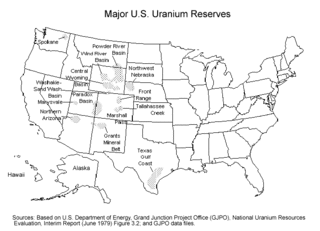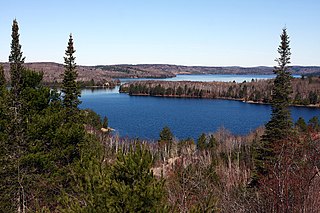
Elliot Lake is a city in Algoma District, Ontario, Canada. It is north of Lake Huron, midway between the cities of Sudbury and Sault Ste. Marie in the Northern Ontario region. Once dubbed the "uranium capital of the world," Elliot Lake has since diversified to a hub for forest harvesting, mine reclamation expertise, and advanced manufacturing. Elliot Lake is now known as a place for affordable retirement living, waterfront cottage lots and as a four-season destination.

The Ranger Uranium Mine was a uranium mine in the Northern Territory of Australia. The site is surrounded by, but separate from Kakadu National Park, 230 km east of Darwin. The orebody was discovered in late 1969, and the mine commenced operation in 1980, reaching full production of uranium oxide in 1981 and ceased stockpile processing on 8 January 2021. Mining activities had ceased in 2012. It is owned and operated by Energy Resources of Australia (ERA), a public company 86.33% owned by Rio Tinto Group, the remainder held by the public. Uranium mined at Ranger was sold for use in nuclear power stations in Japan, South Korea, China, UK, France, Germany, Spain, Sweden and the United States.

The Athabasca Basin is a region in the Canadian Shield of northern Saskatchewan and Alberta, Canada. It is best known as the world's leading source of high-grade uranium and currently supplies about 20% of the world's uranium.
The Key Lake mine is a former uranium mine in Saskatchewan, Canada. It is 570 kilometres (350 mi) north of Saskatoon by air on the southern rim of the uranium-rich Athabasca Basin. Key Lake was initially developed to open-pit mine two nearby uranium ore deposits: the Gaertner deposit and the Deilmann deposit. Mining of this ore ceased in the late 1990s; the Key Lake mill now processes uranium ore from the McArthur River mine and from existing stockpiles on site. High-grade ore from McArthur river is blended with lower grade local rock before being passed through the mill. The mill has a permitted annual production capacity of 25 million pounds of U3O8. In addition, ammonium sulfate fertilizer is produced as a byproduct from used reagents. The pits of the mined out local deposits are being used as mill tailings management facilities.
The McClean Lake mine is a uranium mine and milling operation located west of Wollaston Lake, about 700 kilometres north of Saskatoon, in the Athabasca Basin region of Saskatchewan, Canada. The McClean ore body was discovered in 1979, followed by the discovery of the JEB ore body in 1982. From 1985 to 1990, a cluster of deposits named Sue A, Sue B and Sue C were discovered.
Rio Algom was a mining corporation that was purchased by Billiton in 2000 and is now part of BHP.

Uranium mining in the United States produced 173,875 pounds (78.9 tonnes) of U3O8 in 2019, 88% lower than the 2018 production of 1,447,945 pounds (656.8 tonnes) of U3O8 and the lowest US annual production since 1948. The 2019 production represents 0.3% of the anticipated uranium fuel requirements of the US's nuclear power reactors for the year.

Madawaska Mine (previously known as Faraday Mine) is a decommissioned underground uranium mine in Faraday, near the town of Bancroft, Ontario, which produced 9 million pounds (4,082 tonnes) of U3O8 concentrate, at an average ore grade of 0.1074%, during its two periods of production.

Canada is the world's second largest producer of uranium, behind Kazakhstan. In 2009, 20% of the world's primary uranium production came from mines in Canada. 14.5% of the world production came from one mine, McArthur River. Currently the only producing area in Canada is northern Saskatchewan, although other areas have had active mines in the past.
Orano Canada is a uranium mining, milling, and exploration company headquartered in Saskatoon, Saskatchewan, Canada. Orano is a subsidiary of the Orano Group, an international nuclear energy company headquartered in Paris, France with 16,000 employees worldwide.

Hathor Exploration Limited is a uranium exploration company based in Vancouver, British Columbia, Canada. Its exploration office is located in Saskatoon, Saskatchewan, Canada. Hathor's exploration projects concentrate on properties within the Athabasca Basin of Northern Saskatchewan, Canada.
The world's largest producer of uranium is Kazakhstan, which in 2019 produced 43% of the world's mining output. Canada was the next largest producer with a 13% share, followed by Australia with 12%. Uranium has been mined in every continent except Antarctica.
Fission Uranium Corp. is a mineral exploration company. It is engaged in the exploration and development of uranium assets. Its sole project is the Patterson Lake South (PLS) Project located in Canada's Athabasca Basin District.

The successor of multiple historical Canadian mining and energy companies, EWL Management Limited was an Alberta based corporation that owned five decommissioned mines in Ontario, including three former uranium mines.

Uranium mining around Bancroft, Ontario, was conducted at four sites, beginning in the early 1950s and concluding by 1982. Bancroft was one of two major uranium-producing areas in Ontario, and one of seven in Canada, all located along the edge of the Canadian Shield. In the context of mining, the "Bancroft area" includes Haliburton, Hastings, and Renfrew counties, and all areas between Minden and Lake Clear. Activity in the mid-1950s was described by engineer A. S. Bayne in a 1977 report as the "greatest uranium prospecting rush in the world".
The Royal Commission on the Health and Safety of Workers in Mines, informally known as the Ham Commission, was a 1974 Canadian royal commission founded to investigate and report on the safety of underground mines.
The Elliot Lake Miners Strike was a wildcat strike by approximately 1,000 uranium miners who worked at Denison uranium mine in the Elliot Lake area of Ontario, Canada. The strike was the first time that Canadian workers had taken industrial action over safety concerns, and it led to Ontario Premier Bill Davis creating a royal commission which led to the creation of new health and safety legislation.

Uranium mining in the Elliot Lake area represents one of two major uranium-producing areas in Ontario, and one of seven in Canada.

Quirke Lake is body of water located in Ontario, Canada. It is located in the Quirke Lake basin, a geological basin the northern part of the Huronian Supergroup. The lake is proximate to five decommissioned uranium mines.










